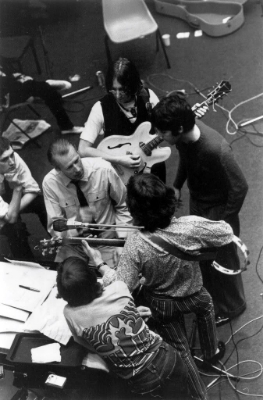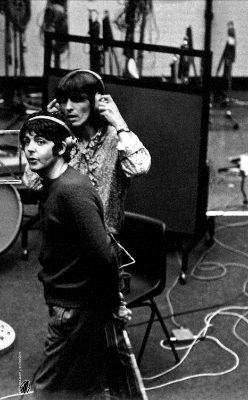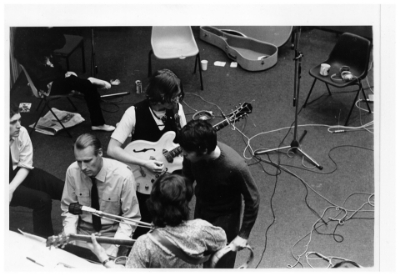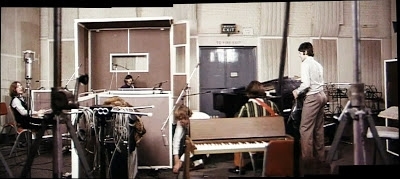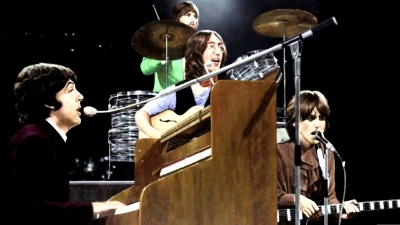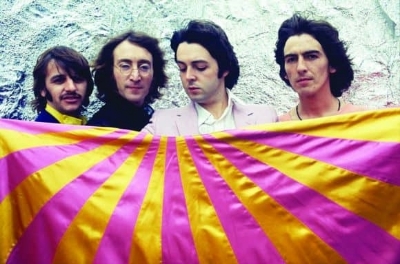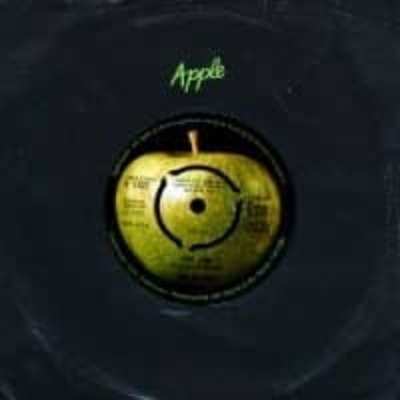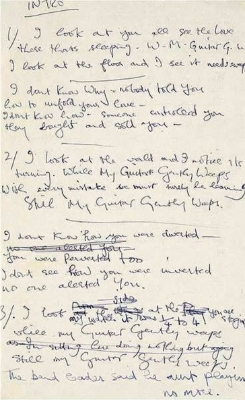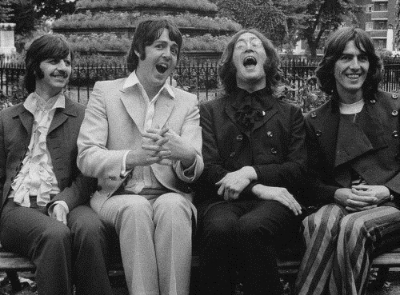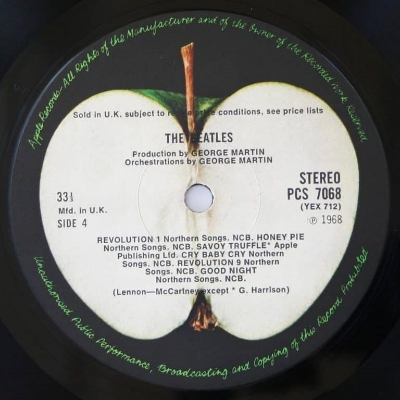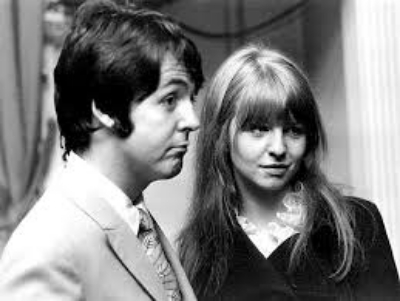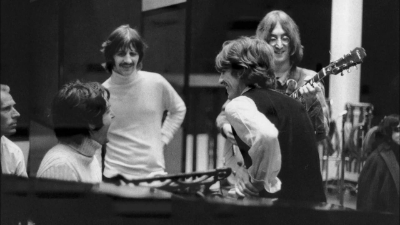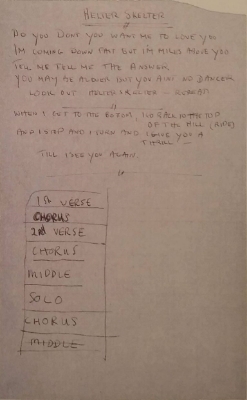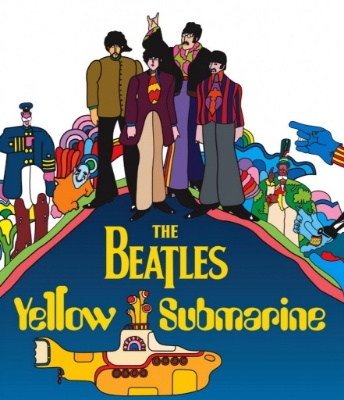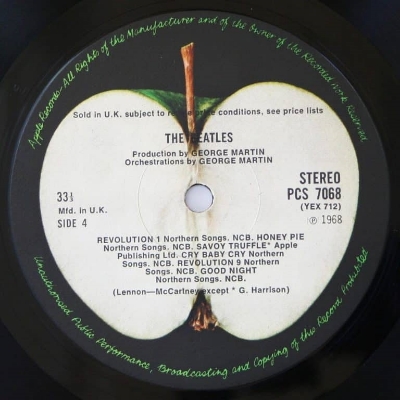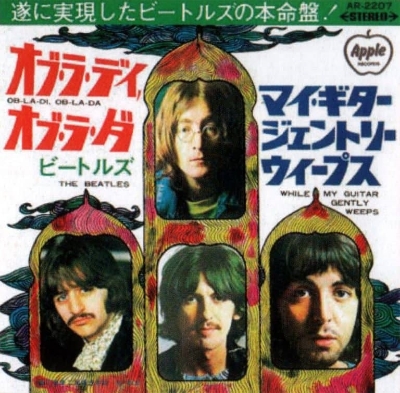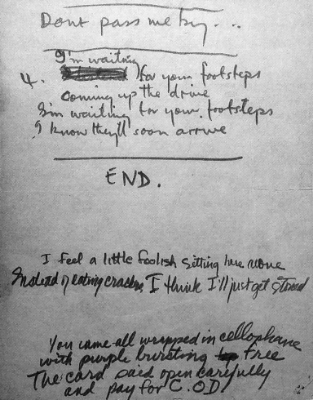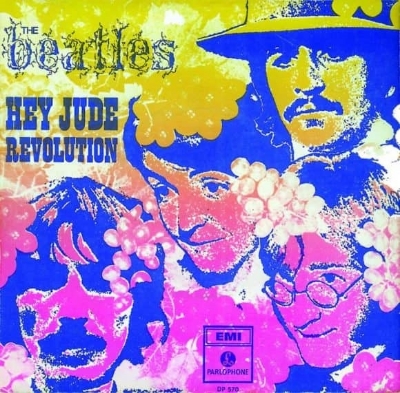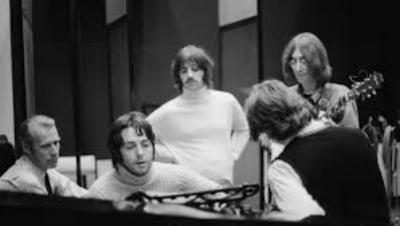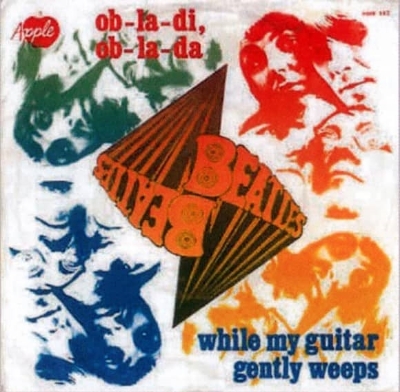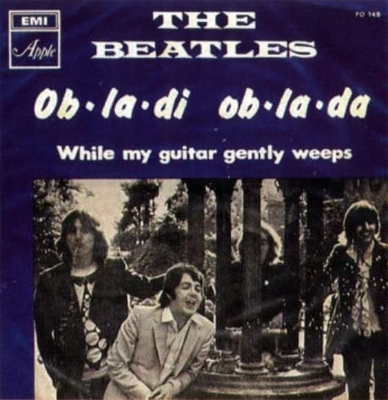The Beatles recording "Hey Jude"
Fab Four Blog
Friday 2 August 1968 Studio
Trident Studios, St Anne's Court, London
Producer: George Martin
Engineer: Barry Sheffield
After completing the recording of Hey Jude during the previous day's session, The Beatles began mixing the song.
As with the recording, the mixing took place at Trident Studios in London's Soho. The session began at 2pm and ended at 1.30am.
In that time just three stereo mixes were made, the last of which was judged to be the best. On 6 August 1968 they mixed Hey Jude in mono, before taking the tapes back to Abbey Road for further work.
Thursday 1 August 1968 Studio
Trident Studios, St Anne's Court, London
Producer: George Martin
Engineer: Barry Sheffield
Having recorded the basic rhythm track for Hey Jude the previous day, The Beatles finished the recording during this 5pm-3am session.
The session took place at Trident Studios in London's Soho, which had been chosen for its eight-track recording facilities. Overdubs added to take one included lead and backing vocals, bass guitar, tambourine, handclaps, and a 36-piece orchestra.
The orchestra featured 10 violins, three violas, three cellos, two flutes, contrabassoon, bassoon, two clarinets, contrabass clarinet, four trumpets, four trombones, two horns, two string basses and percussion.
The session musicians were also asked, for a double fee, to clap their hands and contribute backing vocals; one musician reportedly refused, saying: "I'm not going to clap my hands and sing Paul McCartney's bloody song!"
Trident Studios, St Anne's Court, London
Producer: George Martin
Engineer: Barry Sheffield
Following two days of rehearsals and rough takes, The Beatles finally began recording Hey Jude properly.
The session took place from 2pm-4am at Trident Studios at 17 St Anne's Court, London. Unlike Abbey Road, Trident had operational eight-track recording facilities, and The Beatles were keen to exploit the new technology.
The group recorded four takes of the rhythm track, with Paul McCartney on piano and guide vocals, John Lennon playing acoustic guitar, George Harrison on electric guitar and Ringo Starr on drums. Take one was considered the best, and further overdubs were added on this night and the next.
There is an amusing story about recording it. We were at Trident Studios in Soho, and Ringo walked out to go to the toilet and I hadn't noticed. The toilet was only a few yards from his drum booth, but he'd gone past my back and I still thought he was in his drum booth. I started what was the actual take, and 'Hey Jude' goes on for hours before the drums come in and while I was doing it I suddenly felt Ringo tiptoeing past my back rather quickly, trying to get to his drums. And just as he got to his drums, boom boom boom, his timing was absolutely impeccable. So I think when those things happen, you have a little laugh and a light bulb goes off in your head and you think, This is the take! and you put a little more into it. You think, oh, fuck! This has got to be the take, what just happened was so magic! So we did that and we made a pretty good record.
Paul McCartney
Many Years From Now, Barry Miles
EMI Studios, Abbey Road, 30 July 1968 Seventeen takes were recorded, numbered 7-23, which saw The Beatles refining the arrangement prior to taking it to London's Trident Studios, which had eight-track recording facilities. A film crew was present in the studio, capturing footage for a documentary named Music! which was being made by the National Music Council of Great Britain. The footage shows the group working mostly on take nine, with McCartney on vocals and piano, John Lennon playing an acoustic guitar and singing, and Ringo Starr on drums. Track Listing: 01. Hey Jude (Rehearsal Take) [0:00] 02. St. Louis Blues [0:27] 03. Hey Jude (Rehearsal Take) [0:44] 04. Las Vegas Tune [2:09] 04. St. Louis Blues [2:26] 05. Hey Jude (Rehearsal Take) [3:24] 06. Hey Jude (Take 8) [3:37] 07. Hey Jude (Take 9) [3:55]
The Beatles in the recording studio (Studio Two, EMI Studios, London). George Martin is absent from this session, which sees the first recordings (six takes) of Hey Jude. One of these takes was released on The Beatles Anthology 3 (Disc one, Track 17).
The Mad Day Out: location one
In the early summer of 1968, Paul McCartney telephoned esteemed war photographer Don McCullin to ask him to spend a day photographing The Beatles. The group was in need of new publicity images, and wanted to get away from the recording studio temporarily.
The chosen day was 28 July 1968. The Beatles and McCullin were joined by five others with cameras – Ronald Fitzgibbon, Stephen Goldblatt, Tom Murray, Tony Bramwell and Mal Evans – plus Yoko Ono, McCartney's girlfriend Francie Schwartz, and Gary Evans, Mal's six-year-old son.
There were seven key locations around London in what became known as the Mad Day Out.
The first location was Thomson House, the centre of the newspaper empire owned by Lord Thomson, where The Times and The Sunday Times were based. The building was demolished in 1969.
Thomson House had a photographic studio in its penthouse, which had been built for photographer Lord Snowdon and was often used by Apple's snappers John Kelly and Stephen Goldblatt.
For the first shots, The Beatles stood against a blue backdrop and a fan was pointed at them to blow their hair away. While in the studio the group also used props including: four coloured sheets which were used as capes; a Liverpool Football Club rosette worn by McCartney; crash helmets and diving googles; a boot, positioned on the head of Ringo Starr; and a bugle, played by George Harrison. A crumpled aluminium foil background was also used in some photographs.
It was quiet and they came to the Sunday Times building on Gray's Inn Road. At the top of the building was a photo studio that had been created by Tony Snowdon. There was no agenda except they wanted to give Life magazine a cover picture, which I photographed in colour. I used Ektachrome, and Ringo's chrome yellow shirt jumped out of the blue of his suit. I turned on the wind machine...
The wind machine was throwing their hair around and their famous faces looked like the figures on Mount Rushmore. To my amazement it worked and we got a beautiful cover. Thinking back on it, Life used to pay five hundred quid for a cover so maybe I actually lost out on it, but I was thrilled. Don McCullin (A Day In The Life Of The Beatles)
Location two for the Mad Day Out was at the Mercury Theatre in Notting Hill, London.
The Beatles are taking a break.
Hey Jude was the first release on The Beatles' own Apple Records label. It was a ballad written by Paul McCartney, to comfort John Lennon's son Julian during the divorce of his parents.
Hey Jude is a damn good set of lyrics and I made no contribution to that.
John Lennon, 1980
All We Are Saying, David Sheff
It was written in June 1968,as McCartney drove his Aston Martin to Weybridge to visit Cynthia Lennon and her son. On the journey he began thinking about their changing lives, and of the past times he had spent writing with Lennon at the Weybridge house.
I thought, as a friend of the family, I would motor out to Weybridge and tell them that everything was all right: to try and cheer them up, basically, and see how they were. I had about an hour's drive. I would always turn the radio off and try and make up songs, just in case... I started singing: 'Hey Jules – don't make it bad, take a sad song, and make it better...' It was optimistic, a hopeful message for Julian: 'Come on, man, your parents got divorced. I know you're not happy, but you'll be OK.'
I eventually changed 'Jules' to 'Jude'. One of the characters in Oklahoma is called Jud, and I like the name.
Paul McCartney
Anthology
Recording: While My Guitar Gently Weeps
Recording: While My Guitar Gently Weeps
Thursday 25 July 1968 George Harrison, Studio
Studio Two, EMI Studios, Abbey Road
Producer: George Martin
Engineer: Ken Scott
Although George Harrison had written a number of songs prior to and during The Beatles' 1968 trip to India, he was yet to record any for the White Album. That changed during this session, when he recorded the first version of While My Guitar Gently Weeps.
The Beatles first rehearsed a number of takes of the song, which were recorded and filled two tape reels. These were taken away by Harrison at the end of the session, and the instrumentation and arrangement is unknown.
Harrison did, however, record a solo acoustic version on this day, onto which a harmonium, possibly played by Paul McCartney, was overdubbed. This take was released on 1996's Anthology 3 and, augmented with a string arrangement, on the Love album.
The Anthology mix was prepared by Geoff Emerick in 1984 for the unreleased Sessions album, and featured a looped ending of the final guitar phrase. It also omitted Harrison's final comment to the control room: "Let's hear that back!"
The Beatles in the recording studio (Studio Two, EMI Studios, London). Recording Sexy Sadie (23 takes). But The Beatles will start a second re-make in August. At the end of the session, various and sundry sound effects are taped.
Recording: A Beginning, Good Night
Studio One, EMI Studios, Abbey Road
Producer: George Martin
Engineer: Ken Scott
This session took place in Abbey Road's largest studio, where an orchestra and choir were recorded for two White Album songs.
The first piece was an introductory piece for Don't Pass Me By. Released on Anthology 3 as A Beginning, the piece had already featured in the Yellow Submarine animated film, which had had its world première five days previously on 17 July 1968.
George Martin evidently thought the piece would work as a suitable introduction to Don't Pass Me By, and his score was recorded in four takes. Twelve violins, three violas, three cellos, three flutes, and harp, clarinet, horn, vibraphone and string bass were all used.
The same musicians then performed the score for Good Night. The Beatles' previous attempts at recording the song were discarded, and the orchestra recorded their parts in 12 attempts. These takes were numbered 23-34, the last of which was marked 'best'.
The flutes, violins, violas, horn and clarinet were recorded onto one track, with cellos and string bass on another. The vocals in the chorus, plus harp and extra flutes were overdubbed onto track three, and Ringo Starr's vocals plus backing were added to the fourth.
The extra vocals were by the Mike Sammes Singers, who numbered four men and four women. The track three overdub was recorded between 10.30-11.50pm, and track four was taped between 11.50pm and 1.40am.
The Beatles are busy recording "Sexy Sadie"
Jane Asher announces her split from Paul McCartney
In an appearance on the BBC Television show Dee Time, Jane Asher announced to the host, Simon Dee, that her engagement to Paul McCartney was over.
I haven't broken it off, but it is broken off, finished.
I know it sounds corny, but we still see each other and love each other, but it hasn't worked out. Perhaps we'll be childhood sweethearts and meet again and get married when we're about 70.
Tellingly, Asher had failed to attend the world première of Yellow Submarine three days earlier; all the other Beatles' partners were there.
I always feel very wary including Jane in The Beatles' history. She's never gone into print about our relationship, whilst everyone on earth has sold their story. So I'd feel weird being the one to kiss and tell.
We had a good relationship. Even with touring there were enough occasions to keep a reasonable relationship going. To tell the truth, the women at that time got sidelined. Now it would be seen as very chauvinist of us. Then it was like: 'We are four miners who go down the pit. You don't need women down the pit, do you? We won't have women down the pit.' A lot of what we, The Beatles, did was very much in an enclosed scene. Other people found it difficult – even John's wife, Cynthia, found it very difficult – to penetrate the screen that we had around us. As a kind of safety barrier we had a lot of 'in' jokes, little signs, references to music; we had a common bond in that and it was very difficult for any 'outsider' to penetrate. That possibly wasn't good for relationships back then. Paul McCartney/Anthology
McCartney and Asher had been together for five years, since meeting at the Royal Albert Hall in 1963. However, McCartney had a string of other girls, mainly while The Beatles were touring – and in 1968 began an affair with an American woman, Francie Schwartz.
Asher arrived unexpectedly at McCartney's home in Cavendish Avenue, London, where she reportedly found him in bed with Schwartz. She walked out and sent her mother to collect her belongings, signalling an end to the relationship.
I think inevitably when I moved to Cavendish Avenue, I realised that she and I weren't really going to be the thing we'd always thought we might be. Once or twice we talked about getting married, and plans were afoot but I don't know, something really made me nervous about the whole thing. It just never settled with me, and as that's very important for me, things must feel comfortable for me, I think it's a pretty good gauge if you're lucky enough. You're not always lucky enough, but if they can feel comfortable then there's something very special about that feeling. I hadn't quite managed to be able to get it with Jane.
Paul McCartney
Many Years From Now, Barry Miles
Recording: Sexy Sadie
The Beatles began recording Sexy Sadie, John Lennon's barbed tribute to Maharishi Mahesh Yogi, during this 7.30pm-4am session.
More than three tape reels were filled with rehearsals, as the group searched for a successful arrangement. Nothing was used from this session, although the recordings to offer a revealing insight into the various attitudes within The Beatles at the time.
The recordings featured Lennon on lead vocals and acoustic guitar, George Harrison on electric guitar, Paul McCartney playing an organ and Ringo Starr on drums. Each of the day's takes lasted between 5'36" and 8'00", partly because of the slower tempo.
Twenty-one takes of Sexy Sadie were recorded, although it was clear that none would be given further overdubs. Take six was, however, released on 1996's Anthology 3.
Several improvisations also made their way onto tape. At one stage Lennon sang an uncomplimentary song – later bootlegged as Brian Epstein Blues – about The Beatles' former manager.
What about Brian Epstein and his brother Sam?
They was workin' in a coal mine, doing what I am.
And what about brother Andy, he's shuttin' down the fire.
But if you tell the time about his brother Sam,
Wah dap, a wah dap bop
Wah dup, a ba ba bow...
About his brother Clive, he's a dirty old man,
Well what about Brian Epstein, he's god damned in jail.
He's working in the coal mine sittin' dead as a fail (?).
His mother's dirty Queenie, well she's the queen of them all.
Lennon also sang to McCartney some crude alternative lyrics to Sexy Sadie:
Sexy Sadie, you little twat
Who the fuck do you think you are?
Who the fuck do you think you are?
Oh, you cunt.
After singing them he jokingly asked McCartney if that was how it should sound, and McCartney responds: "With a little more sympathy."
Three days after The Beatles' engineer Geoff Emerick quit working with the group in protest at the worsening atmosphere in the studio, the microphones captured a frosty exchange between George Harrison and George Martin.
Ken Scott: Sorry George, what did you say?
George Harrison: I said it's no point in Mr Martin being uptight.
Paul McCartney: Right.
Harrison: You know, we're all here to do this, and if you want to be uptight...
George Martin: I don't know what to say to you, George.
Harrison: I mean, you're very negative!
At another point on the tape, Yoko Ono suggested that The Beatles might be able to play the song better. Lennon, sensing the volatile situation within the group, responded by saying "Well, maybe I can."
The Beatles continued work on Sexy Sadie on 24 July 1968.
Studio Two, EMI Studios, Abbey Road
Producer: George Martin
Engineer: Ken Scott
The Beatles completed the recording of Cry Baby Cry during this day's two sessions, and also began work on Helter Skelter.
The first session began at 2.30pm and lasted seven hours. Just one track was spare on the four-track tape, so The Beatles filled it with a number of simultaneous recordings. John Lennon redid his lead vocals in the verses, with harmonies by Paul McCartney in places; George Martin played a descending harmonium part in the introduction; Ringo Starr shook a tambourine; and George Harrison added electric guitar and tea party effects were made during the "Duchess of Kirkcaldy" verse.
Cry Baby Cry was transferred to eight-track tape on 17 September 1968, but no further music was added.
The day's second session began at 10.30pm and ended at 3.30am. The Beatles recorded three takes of Helter Skelter, which were essentially rehearsals; they lasted 10'40", 12'35" and 27'11" respectively.
The last was the longest recording in the group's career. An edited mix of take two, meanwhile, was released on 1996's Anthology 3.
I made it clear to George Martin when we doing Anthology 3, that the fans are desperate to hear this and I urged him to listen to it, because I don't think initially he was going to do so. He listened to it, and he said: "Well, why is this important?" I said forget the quality of the sound, or forget the fact that it's not quite in tune or whatever, what a producer would normally be looking for, just respect the fact please that it is hailed as the most important outtake of them all, and the fans will go crazy if you don't include this on the Anthology.
So he took all that on board, which George always does, and he's very good at that sort of thing, he listens. But, the next time I went in there, they said: "Here it is," and it was like five minutes, and they'd trimmed it right down. And in fact they didn't use the 27-minute one, there was another one as well that was 12 minutes, which they used, and they'd trimmed it down to five minutes. They said: "This is all people will stand, they won't stand the whole thing." And I said: "Well, I think a lot of them will actually..."
Mark Lewisohn
The takes were recorded over two rehearsal reels of Cry Baby Cry made on 15 July. At this stage Helter Skelter was a blues-based jam, although most of the lyrics and chord changes were in place.
They recorded the long versions of Helter Skelter with live tape echo. Echo would normally be added at remix stage otherwise it can't be altered, but this time they wanted it live. One of the versions developed into a jam which went into and then back out of a somewhat bizarre version of Blue Moon. The problem was, although we were recording them at 15 ips [inches per second] – which meant that we'd get roughly half an hour of time on the tape – the machine we were running for the tape echo was going at 30 ips, in other words 15 minutes... The Beatles were jamming away, completely oblivious to the world and we didn't know what to do because they all had foldback in their headphones so that they could hear the echo. We knew that if we stopped it they would notice.
In the end we decided that the best thing to do was stop the tape echo machine and rewind it. So at one point the echo suddenly stopped and you could hear 'bllllrrrrippppp' as it was spooled back. This prompted Paul to put in some kind of clever vocal improvisation based around the chattering sound!
These recordings featured two electric guitars, bass and drums all on the same track, and McCartney's vocals on another. It is possible that Lennon played the bass on these recordings.
Following this session, The Beatles didn't return to Helter Skelter until 9 September 1968.
Source: Brian Gibson, technical engineer
The Complete Beatles Recording Sessions, Mark Lewisoh
July 17, 1968: Beatles’ Yellow Submarine Premiere
The animated feature film inspired by and adapted from themes and ideas in songs by The Beatles and starring cartoon characters based on John, Paul, George and Ringo made its world premiere at the London Pavilion in Piccadilly Circus on July 17, 1968.
All four Beatles were in attendance: John Lennon with Yoko Ono, Ringo Starr with wife Maureen Starkey and George Harrison accompanied by his spouse Pattie. Paul McCartney came solo; three days later his fiance Jane Asher announces that their engagement has ended.
As was typical of any event in the 1960s where the Beatles were present, a mob scene ensued on the street outside
The Beatles themselves only appeared in a short live-action snippet at the end of Yellow Submarine and their characters were voiced by professional actors. The film has come to be recognized as a genre-changing work that led to animation gaining greater respect as an art form and Time magazine noted that it “turned into a smash hit, delighting adolescents and esthetes alike” Although the band members were initially skeptical about the film, in 1995 all three surviving Beatles expressed an appreciation for it in The Beatles Anthology documentary series.nteresting bit of trivia: he Harrison song in the movie, “Only a Northern Song,” was written as a cynical commentary on the music publishing company, Northern Songs, that Beatles manager Brian Epstein had formed with publisher Dick James. The deal was unfavorable to the band who eventually lost control of their very valuable song copyrights.
Recording: Cry Baby Cry
Studio Two, EMI Studios, Abbey Road
Producer: George Martin
Engineer: Geoff Emerick
Following a six-hour rehearsal session on 15 July 1968, The Beatles began proper recordings of Cry Baby Cry on this day.
The day was divided into two separate sessions, both held in Abbey Road's Studio Two. The first took place from 4-9pm, and the second from 10pm to 2am.
The group recorded 10 takes of the song, with John Lennon on acoustic guitar and vocals, Paul McCartney playing bass guitar, and Ringo Starr on drums. Take one was released on 1996's Anthology 3.
Two reduction mixes of take 10 combined the instruments but kept Lennon's vocals only in the chorus. These mixes were numbered takes 11 and 12, and the latter became the basis for further overdubs.
During the second session Lennon recorded a piano part and George Martin added harmonium, both on the same track. The fourth track of the tape would be filled on 18 July 1968.
Recording, mixing: Revolution, Ob-La-Di, Ob-La-Da, Cry Baby Cry
Recording, mixing: Revolution, Ob-La-Di, Ob-La-Da, Cry Baby Cry
Monday 15 July 1968 Studio
Studio Two, EMI Studios, Abbey Road
Producer: George Martin
Engineer: Geoff Emerick
The Beatles completed work on two songs, and began another, during two sessions on this day.
The first session took place from 3.30-8pm in Abbey Road's Studio Two. Two mono mixes of Revolution, numbered 20 and 21, were created.
These mixes were to replace the four created on 12 July 1968, which John Lennon thought to be substandard. Mix 21 was duly selected for the b-side of the Hey Jude single.
Ob-La-Di, Ob-La-Da was the second song to be tackled. Paul McCartney had decided to re-record his lead vocals. Background contributions from the rest of the group, included various jokey noises such as forced laughter, and "arm", "leg" and "foot", after Molly or Desmond let the children lend a hand.
Ten mono mixes were then made, which were numbered 12-21. This saw the completion of Ob-La-Di, Ob-La-Da, doubtless to the relief of the group.
The second session started at 9pm and finished at 3am on the morning of 16 July. The Beatles began work on Cry Baby Cry, although these were unnumbered rehearsal takes rather than proper attempts. Four reels of tape were filled, but unfortunately most of the recordings were erased in subsequent sessions.
source: beatlesbible.com
The Beatles in-between recording.
In-between recording "Don’t Pass Me By, Ob-La-Di, Ob-La-Da, Revolution"
Recording, mixing: Don’t Pass Me By, Ob-La-Di, Ob-La-Da, Revolution
Studio Two, EMI Studios, Abbey Road
Producer: George Martin
Engineer: Geoff Emerick
Ringo Starr's first published composition Don't Pass Me By was completed during the first of this day's sessions, which began at 3pm and lasted eight hours.
Jack Fallon had been a booking agent for five English concerts played by The Beatles between March 1962 and June 1963. They were therefore surprised to see him turn up as the session violinist booked by EMI to perform on the song.
George Martin had jotted down a 12-bar blues for me. A lot of country fiddle playing is double-stop [two notes played simultaneously] but Paul and George Martin – they were doing the arranging – suggested I play it single note. So it wasn't really the country sound they originally wanted. But they seemed pleased. Ringo was around too, keeping an eye on his song.
The violin overdub was completed by 6.40pm. Afterwards Paul McCartney re-recorded his bass guitar part, and Starr added a piano part, fed through a Leslie speaker, which included the tinkling introduction.
Four mono mixes of Don't Pass Me By were then created. Starr took home a copy of the last of these, which he later gave to his friend Peter Sellers. The album contained a different mix, however, which was made on 11 October 1968.
Two mono mixes were also made of Ob-La-Di, Ob-La-Da, numbered 10 and 11, at the end of the session. These mixes were rendered unnecessary, however, after Paul McCartney decided to re-record his lead vocals on 15 July.
Source: Jack Fallon - The Complete Beatles Recording Sessions, Mark Lewisohn
Recording, mixing: Revolution, Ob-La-Di, Ob-La-Da
Thursday 11 July 1968 Studio
Studio Three, EMI Studios, Abbey Road
Producer: George Martin
Engineer: Geoff Emerick
Two separate recording sessions took place on this day at Abbey Road's Studio Three.
The first was for overdubs onto Revolution, which was destined to be part of The Beatles' next single. Session player Nicky Hopkins added electric piano to track four on the tape, playing a solo and again in the coda.
The electric piano overdub took up the whole of the 4-7pm session. The second session that evening began with three saxophones added to Ob-La-Di, Ob-La-Da. The session performers' names were undocumented.
The Beatles then turned their attention back to Revolution. A third reduction mix – take 16 – was made, which combined tracks three and four onto the third track of a new tape. Paul McCartney then recorded a bass guitar part, but it was re-recorded the next day.
Risking the antagonism of the studio engineers and tape operator, The Beatles then returned to Ob-La-Di, Ob-La-Da. Another reduction mix was created, which was numbered take 23. McCartney then double-tracked his bass guitar line, as the original had become buried in all the previous mixes.
The session ended at 3.45am, after two mono mixes of Ob-La-Di had been created. These were improved upon on 12 July 1968, but McCartney re-recorded his lead vocals on 15 July, rendering them unnecessary.
Recording: Revolution
Wednesday 10 July 1968 Studio
Studio Three, EMI Studios, Abbey Road
Producer: George Martin
Engineer: Geoff Emerick
Following a set of rehearsals on the previous evening, The Beatles began proper recording of Revolution, which was to feature on their next single Hey Jude.
Perhaps the most distinctive aspect of the recording was the two distorted lead guitars, a sound achieved by plugging the instruments directly into the recording console. These were recorded onto tracks one and two, while Ringo Starr's drums were recorded onto the third.
They were overdriving two of the mic preamps on an EMI REDD desk that was being used at the time. I was a mastering engineer at the beginning of the White Album recordings, and I happened to go to Studio 3, where they were recording that track.
John, Paul and George were all in the control room and had their guitars plugged directly into the board, and Ringo was all on his own on the drums in the studio. Geoff Emerick came up with a very cool way to distort by going in one preamp to overload and into another preamp to distort it even more.
The drums were double-tracked onto the tape's fourth track, to add further weight to the song. Three reduction mixes were then made – takes 11-13 – which put the guitars onto track one and the drums onto two.
John Lennon recorded his lead vocals onto track three. Another vocal part was overdubbed onto track four, for which he sang selected words to add emphasis, and screamed in the introduction. Handclaps and a drum crack by Starr in the third bar of the song were also recorded on this fourth track.
Before the session ended at 1.30am two new reduction mixes were made. These were numbered 14 and 15, and combined tracks three and four onto track three of a new tape.
John Lennon took away a mono copy of take 15, prior to further overdubs beginning on the next day.
Recording: Ob-La-Di, Ob-La-Da, Revolution
Studio Three, EMI Studios, Abbey Road
Producer: George Martin
Engineer: Geoff Emerick
Although The Beatles had recorded a remake of Ob-La-Di, Ob-La-Da during the previous night's session, they began this day's work by starting a third version.
Paul McCartney led the group through two new takes of the song, numbered 20 and 21, in a five-hour session beginning at 4pm. Following an hour's break, however, he decided to return to the previous night's take 13, which became the basis for the master version released on the White Album. The lead and backing vocals were wiped and re-recorded, although these were replaced by more recordings made on 15 July 1968.
A reduction mix of take 13 was then made, numbered take 22, accounting for the earlier takes. Handclaps and more vocal noises were then added, along with piano in the final verse. The song was completed on 15 July.
This second session ended at 3.30am. Before it did, The Beatles began work on a remake of Revolution, which was to feature on their next single as the b-side of Hey Jude. McCartney and George Harrison had decreed that Revolution 1 was not commercial-sounding enough, much to the annoyance of John Lennon.
Although this night's performances were recorded, this was more a rehearsal of Revolution than a proper session. It featured lead and rhythm guitars, bass guitar and drums, plus Lennon's lead vocals. The tape was later wiped, however, and replaced with proper takes on 10 July.
Recording: Ob-La-Di, Ob-La-Da
Studio Two, EMI Studios, Abbey Road
Producer: George Martin
Engineer: Geoff Emerick
Following three abortive days of work on Ob-La-Di, Ob-La-Da, The Beatles started afresh with a remake during this session.
The group recorded 12 takes of the backing track, with Paul McCartney on distorted bass guitar, John Lennon on piano, George Harrison playing an acoustic guitar and Ringo Starr on drums. Each instrument was recorded onto a separate track on the tape.
Ob-La-Di, Ob-La-Da's distinctive piano introduction came about during this session, after Lennon grew frustrated with playing the song.
After about four or five nights doing Ob-La-Di, Ob-La-Da John Lennon came to the session really stoned, totally out of it on something or other, and he said 'Alright, we're gonna do Ob-La-Di, Ob-La-Da'. He went straight to the piano and smashed the keys with an almighty amount of volume, twice the speed of how they'd done it before, and said 'This is it! Come on!' He was really aggravated. That was the version they ended up using.
Geoff Emerick
The Complete Beatles Recording Sessions, Mark Lewisohn
A reduction mix, numbered take 13, put all the instruments onto track one of the tape. Initial lead and backing vocals were then overdubbed onto tracks three and four, and maracas and bongos were added to track two.
An unnumbered rough mono mix was created at the end of the session. This was taken away by McCartney to be reviewed, although the next day's session began with yet another remake. However, they later returned to this night's take 13, which became the basis for the album version.
The Beatles are busy recording the White Album, but with tension arising.
Recording: Ob-La-Di, Ob-La-Da
This session, which took place from 5pm-1.30am, was an eventful one which saw numerous overdubs added to Ob-La-Di, Ob-La-Da.
Between 6pm and 10.30pm three saxophones and a set of bongos were added to the song. The saxophonists were James Gray, Rex Morris and Cyril Reuben, while the percussionist was Jimmy Scott – whose pet phrase Paul McCartney had used for the song's title.
Scott's full name was Jimmy Anonmuogharan Scott Emuakpor. The phrase 'Ob-la-di, ob-la-da' was said to be a Urhobo colloquialism meaning 'Life goes on', but was actually just a family phrase.
Additional percussion – maracas, marimba and claves – were also added, from the second chorus onwards. These were recorded onto track three along with the saxophone and bongos.
Between 10.30pm and 11.45pm a piccolo was overdubbed onto track two, although this was subsequently wiped and replaced by a guitar part played by McCartney. The guitar was added towards the end of the session, and was distorted to make it sound like a bass guitar.
McCartney took away a rough mono mix of Ob-La-Di at the end of the session. After reviewing it over the weekend, he decided the song required a remake, which was begun on Monday 8 July 1968. It was, however, released on 1996's Anthology 3.
- 1970
- 1969
- 1968
- 1967
- 1966
- 1965
- 1964
- 1963
- 1962

